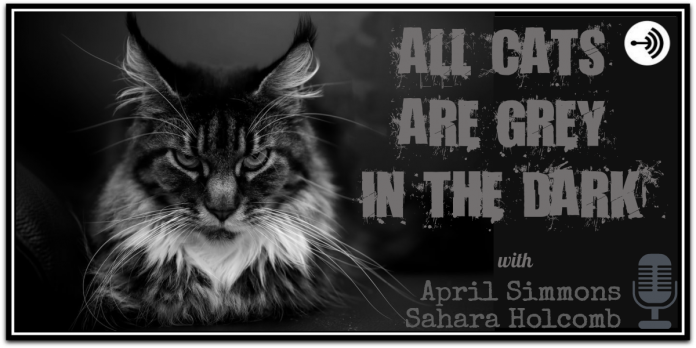The post Marshall Ramsey: Class Five Rapids appeared first on Mississippi Today.
Episode 27: Cults Part Two- If It Smells Funky…
Warning: Explicit language and content*
In episode 27, we discuss the Children of God cult and the Cult of Black Jesus & a bonus about the Foot Reading Cult in part two of our series about cults.
All Cats is part of the Truthseekers Podcast Network.
Host: April Simmons
Special Guest Host: Sabrina
Theme + Editing by April Simmons
http://anchor.fm/april-simmons to donate to our pickles & coffee fund
Contact us at allcatspod@gmail.com
Call us at 662-200-1909
https://linktr.ee/allcats for all our social media links
Shoutout podcasts this week: Wait to Panic & Chills, Thrills, and Kills
The Crimes We’re Into (promo)
Credits:
http://wikipedia.org
https://people.howstuffworks.com/10-infamous-cults3.htm
https://www.bbc.com/news/uk-scotland-44613932
Children Of God — Inside The California Hippie Cult That Encouraged Sexual Abuse Of Kids
https://www.learnreligions.com/children-of-god-cult-4165811
https://abcnews.go.com/Nightline/story?id=3797272&page=1
https://www.independent.co.uk/news/world/australasia/hacked-slashed-and-castrated-how-cannibal-cult-leader-black-jesus-steven-tari-met-his-death-8795240.html
https://en.wikipedia.org/wiki/Steven_Tari
http://247wallst.com
http://abc.net.au
—
This episode is sponsored by
· Anchor: The easiest way to make a podcast. https://anchor.fm/app
27: Episode 27: Cults Part Two- If It Smells Funky…
Warning: Explicit language and content*
In episode 27, we discuss the Children of God cult and the Cult of Black Jesus & a bonus about the Foot Reading Cult in part two of our series about cults.
All Cats is part of the Truthseekers Podcast Network.
Host: April Simmons
Special Guest Host: Sabrina
Theme + Editing by April Simmons
http://anchor.fm/april-simmons to donate to our pickles & coffee fund
Contact us at allcatspod@gmail.com
Call us at 662-200-1909
https://linktr.ee/allcats for all our social media links
Shoutout podcasts this week: Wait to Panic & Chills, Thrills, and Kills
The Crimes We’re Into (promo)
Credits:
http://wikipedia.org
https://people.howstuffworks.com/10-infamous-cults3.htm
https://www.bbc.com/news/uk-scotland-44613932
Children Of God — Inside The California Hippie Cult That Encouraged Sexual Abuse Of Kids
https://www.learnreligions.com/children-of-god-cult-4165811
https://abcnews.go.com/Nightline/story?id=3797272&page=1
https://www.independent.co.uk/news/world/australasia/hacked-slashed-and-castrated-how-cannibal-cult-leader-black-jesus-steven-tari-met-his-death-8795240.html
https://en.wikipedia.org/wiki/Steven_Tari
http://247wallst.com
http://abc.net.au
—
This episode is sponsored by
· Anchor: The easiest way to make a podcast. https://anchor.fm/app
Episode 27: Cults Part Two- If It Smells Funky…
Warning: Explicit language and content*
In episode 27, we discuss the Children of God cult and the Cult of Black Jesus & a bonus about the Foot Reading Cult in part two of our series about cults.
All Cats is part of the Truthseekers Podcast Network.
Host: April Simmons
Special Guest Host: Sabrina
Theme + Editing by April Simmons
http://anchor.fm/april-simmons to donate to our pickles & coffee fund
Contact us at allcatspod@gmail.com
Call us at 662-200-1909
https://linktr.ee/allcats for all our social media links
Shoutout podcasts this week: Wait to Panic & Chills, Thrills, and Kills
The Crimes We’re Into (promo)
Credits:
http://wikipedia.org
https://people.howstuffworks.com/10-infamous-cults3.htm
https://www.bbc.com/news/uk-scotland-44613932
Children Of God — Inside The California Hippie Cult That Encouraged Sexual Abuse Of Kids
https://www.learnreligions.com/children-of-god-cult-4165811
https://abcnews.go.com/Nightline/story?id=3797272&page=1
https://www.independent.co.uk/news/world/australasia/hacked-slashed-and-castrated-how-cannibal-cult-leader-black-jesus-steven-tari-met-his-death-8795240.html
https://en.wikipedia.org/wiki/Steven_Tari
http://247wallst.com
http://abc.net.au
—
This episode is sponsored by
· Anchor: The easiest way to make a podcast. https://anchor.fm/app
Senate Democrats file resolution to change state flag after earlier action by House members

Rogelio V. Solis, AP
Sons of Confederate Veterans and other groups parade on the grounds of the state Capitol in Jackson, Miss., Tuesday, Jan. 19, 2016.
A group of Democratic senators filed a resolution on Thursday to change Mississippi’s state flag, the last in the nation containing the Confederate battle emblem.
The move means conversations about changing the flag are openly occurring in both chambers of the Capitol for the first time since 2001. Earlier this week, a bipartisan group of House members had privately discussed the issue and begun whipping votes.
The Senate rules suspension, filed on Thursday on 12 Senate Democrats, is required because the legislative deadline has passed to consider a bill to change the flag. It would require a two-thirds vote in both chambers to pass the suspension resolution.
“We are going to see where the votes are,” said Sen. Derrick Simmons of Greenville, the Senate Democratic leader. Simmons said multiple Republicans have indicated to him they support changing the flag. Still, most concede it would be a long shot at best to change the flag at this point in the session.
But in the midst of the recent protests over police brutality and the death of George Floyd at the hands of law enforcement in Minneapolis, there has been renewed interest by some in trying to change the flag. Many view the Confederate battle emblem as a racist symbol, and national groups like NASCAR have banned the image in recent days as protests over racial inequities continue across the nation.
Lt. Gov. Delbert Hosemann will most likely refer the resolution filed Thursday to the Rules Committee chaired by Sen. President Pro Tem Dean Kirby, R-Pearl. Kirby said he does not believe the Legislature should change the flag on its own. He said he would support a vote of the people – similar to what occurred in 2001, when about 64 percent of Mississippi voters opted to keep the old flag.
“Put it on the ballot and let the people make this decision,” Kirby said. “I think that’s where you’ll find most Republicans are on this — at least that’s what they tell me…. (The 2001 referendum) was probably the largest vote we ever had in Rankin County of presidential, statewide, you name it.”
Sen. Chris McDaniel, R-Ellisville, said he supports keeping the old flag, but would not be opposed “to a conversation” on the issue if it was placed on the ballot through a citizen-sponsored initiative instead of through the Legislature.
Sen. Scott DeLano, R-Biloxi, said he is undecided on changing the flag.
“I’d have to see what is proposed, brought forward and how it is brought forward,” DeLano said. “I am concerned that the Legislature doesn’t give it proper due diligence and debate. I want to see it given the proper attention it needs.”
Sen. Walter Michel, R-Ridgeland, was one of few Republican legislators to say publicly Thursday he supported replacing the flag.
Michel said he voted in 2001 to change it and would do so again if it came to a referendum — or if it came before the Senate.
“I’m not afraid to vote as a senator to change it, either,” Michel said. “I’m for changing it.”
One issue that has muddled the debate for some is what flag would replace the current one. The bipartisan group of House members support the Stennis flag.
“I am for any viable alternative to the current flag,” said Sen. David Blount, D-Jackson, one of the co-sponsors of the Senate suspension resolution filed on Thursday. Simmons echoed similar sentiments.
The post Senate Democrats file resolution to change state flag after earlier action by House members appeared first on Mississippi Today.
State unveils options for K-12 schools to reopen in the fall

Eric J. Shelton/Mississippi Today, Report For America
Magee Elementary School students participate in phonics and phonemic awareness exercise Friday, December 6, 2019.
This week the Mississippi Department of Education released guidelines for how K-12 schools should reopen in the fall.
In a document titled “Considerations for reopening Mississippi Schools,” the department outlines a three month timeline with information for school districts to consider as they plan for the upcoming school year. These guidelines were created with a group of 10 superintendents across the state, and list three options for how schools should reopen: traditional, hybrid, or virtual. The guidelines will be updated every three months depending on the coronavirus and its effects. The Institutions of Higher Learning already made the decision that the state’s public colleges and universities will “resume traditional operations” in the fall.
Traditional reopening would mean students are physically present in school so long as districts can continue to follow Centers for Disease Control and Prevention and state department of health guidelines. This plan suggests schools make adjustments to transportation, screen students daily, and limit student movement and gatherings so that social distancing is possible. Additionally, schools are encouraged to create a plan for students and staff who are unable to come to school due to health issues.
A hybrid reopening would mean some combination of in-person instruction and distance learning. Schools could adopt “A/B days,” meaning students would be split into two groups which report to school on alternating days. The guidelines also have the option for elementary students to report to school for in-person instruction, while students in higher grades complete their work through distance learning. Schools could also do some combination of the two options, the guidelines state.
Virtual reopening would have students return to school entirely through distance learning, but the guideline warns that districts must take into consideration whether their community has sufficient internet bandwidth and can mitigate “the digital divide among families.”
The state is not mandating which option districts take. “Local school districts are responsible for designing school schedules that best meet the needs of their communities,” the department said in a press release.
At a Mississippi State Board of Education meeting Thursday, members suspended several policies to help school districts meet requirements and choose one of these three avenues.
For example, in the past the department has required that all students receive 5.5 hours of instructional time per day. That has now been reduced to 4 hours. A similar exception was made for high schools that use Carnegie unit credits to measure course completion. Previously, there was a 140-hour instructional requirement for one-credit courses and a 70-hour instructional requirement for half-credit courses. Now, that will be waived as long as districts, “develop a plan to ensure students master the course content,” the press release states.
Those plans must be approved by districts’ local school boards and posted to their websites by September 30.
Also, school districts no longer have to seek a waiver from the State Board of Education or Commission on School Accreditation if they can’t comply with student-teacher ratios.
Some policies that have been in place will remain for the 2020-2021 school year —districts still have to establish graduation requirements that meet the state’s minimum graduation requirements.
Before the first day of school, local school districts also have to create criteria for whether a student can move on to the next grade as well as come up with “uniform grading policies,” MDE stated in its press release.
If the previous school year is any indication, a hybrid return will likely be popular option. During the 2019-20 school year when school buildings closed because of the pandemic, the department surveyed school districts on how they were delivering instruction. In all, 13 said they were using distance or virtual learning, 16 were sending home packets, and 134 were using a blended approach of the two methods. Five districts said they were using alternative approaches, such as phone calls and peer tutoring, according to the department.
Going entirely virtual is a complicated and expensive undertaking the department is actively working on, as the start of a new school year is roughly eight weeks away. Online learning is not currently a reality in many districts. Census Bureau data shows that statewide, almost one-fifth of Mississippi households do not have a computer and nearly one-third don’t have broadband, the federal standard for internet speeds.
Last month, State Superintendent Carey Wright presented a digital learning plan to the Mississippi Legislature which highlighted five main areas: technology, curriculum, training, computer security and internet connectivity as resources needed for districts to fully implement a digital learning plan. Requirements would include roughly 300,000 laptops or tablets, 40,000 WiFi hotspots, eight high-quality curricula programs, training for students and families, professional development for 30,000 teachers and 450 technology staff, device management support and software licenses, costing nearly $250 million.
The state received millions in federal funds via the Coronavirus Aid, Relief and Economic Security Act which the department intends to use to help pay for this. Gov. Tate Reeves received $34.6 million in a specific fund to be used for education, and the state’s K-12 schools received $169.8 million through the Elementary and Secondary School Emergency Relief Fund. Separately, the Mississippi Legislature has control of $1.2 billion in federal funds to be used for coronavirus relief efforts.
To pay for the $250 million price tag, the department has requested $200 million from the Legislature’s portion of federal funds. The Legislature is still in session working out the state budget, so whether the department is granted those funds remains to be seen.
To pay for the rest, $33 million would have to come from local school districts’ portion of ESSER funds; $5 million from the department’s CARES Act funds; $5 million from the governor’s portion of education CARES Act funds, and $7 million in private funds were requested from the Mississippi Alliance of Nonprofits, according to the department.
“This is such a wonderful opportunity for the state, and…absent COVID-19 and the funding that comes with that, we probably would never have seen this kind of investment in the school districts of Mississippi in my lifetime,” said board member John Kelly during the Thursday meeting.
The post State unveils options for K-12 schools to reopen in the fall appeared first on Mississippi Today.
Marshall Ramsey: Removal
I definitely didn’t have “NASCAR bans the Confederate Flag” on my 2020 Bingo Card.
The post Marshall Ramsey: Removal appeared first on Mississippi Today.
‘Racist relic of the past’: Powerful teachers group pushes to change state flag

Eric J. Shelton/Mississippi Today, Report For America
A fairgoer holds a Mississippi state flag during the Neshoba County Fair on Wednesday, July 31, 2019.
The president of the Mississippi Association of Educators, the state’s teachers union and powerful education lobby, asked teachers across the state to call lawmakers and demand they change the state flag, the last in the nation containing the Confederate battle emblem.
Erica Jones, president of the association, sent an email early Thursday morning to the organization’s thousands of members asking them to “call your state representative and state senator and ask them to support suspending the rules to allow for a bill to change the flag to be considered.”
The call to action comes as a bipartisan group of lawmakers, with House Speaker Philip Gunn’s blessing, is whipping votes and drafting a resolution that would change the state flag.
“Educators are charged with ensuring our students feel safe, cared for, and protected in their schools. That is a daunting task under the best of circumstances,” Jones wrote in the email, which was also posted to the organization’s Facebook page. “When there is a racist relic of the past flying above our schools, it is simply not possible to say we are fulfilling that duty. We would never stand for displaying a symbol of hatred inside of our classrooms. Why should we tolerate it outside of our school buildings, next to the doors our students walk through each and every day?”
Jones continued: “As any of us would tell our students: don’t be a bystander. Be an upstander. If you know something is wrong, speak up. Don’t stand idly by while people are hurting. That’s why we’re calling on lawmakers to do the right thing by speaking up for all of Mississippi’s students and taking down the state flag.”
Mississippi Today reported on Tuesday that several House Republicans and Democrats met behind closed doors to discuss changing the state flag. After later meeting with Gunn, who supports changing the flag, the group began drafting a resolution that would replace the current state flag with the Stennis flag, a design that has gained momentum in recent years.
The conversation behind closed doors this week marks one of the first earnest legislative discussions about changing the state flag since the 2001 referendum in which Mississippians voted nearly 2-to-1 to keep the current flag. It also comes as tens of thousands of black Mississippians and their multi-racial allies march the streets to protest racial inequalities in government.
The Mississippi Association of Educators, one of the most powerful lobbies in the state, putting its weight behind the legislative effort is notable as lawmakers working to change the flag need to garner commitments from at least 35 Republican House members.
House leaders told Mississippi Today on Wednesday that they received private commitments to change the flag from “about 20” Republican House members. “About 20 more” Republicans are on the fence, said Rep. Robert Johnson, the House Democratic leader from Natchez.
The teachers association has successfully swayed votes of lawmakers on both sides of the aisle on key pieces of legislation in recent years. Lawmakers routinely work to satisfy the organization’s policy wishes in efforts to avoid becoming inundated with communications from public school teachers across the state.
Lawmakers this week said they had already been bombarded with calls and emails from Mississippians about changing the flag. Jones’ call to action on Thursday will likely exacerbate that reality.
“It is our duty as educators to continue standing up for our students and advocating for what we know to be right,” Jones wrote. “Changing the flag is not a partisan issue. This is a matter of right and wrong. This flag is wrong, and it’s time to take it down.”
The post ‘Racist relic of the past’: Powerful teachers group pushes to change state flag appeared first on Mississippi Today.
A tour of Mississippi: Jackson City Hall
Color your way through Mississippi with me! Click below to download a coloring sheet of Jackson City Hall.

For all of my coloring sheets, click here.
Don’t miss my next coloring sheet! Sign up below to receive it straight to your inbox.
Don’t miss my art lessons — live every Friday at noon.

The post A tour of Mississippi: Jackson City Hall appeared first on Mississippi Today.
Weekend Forecast
It will be perfect weather to get outside today through the weekend, whether in the yard, at the Tennessee-Tombigbee River, or by the pool. 😎
The UV heat index is high, so be sure to use sunscreen and have an awesome weekend everyone!!
FRIDAY: Sunny, with a high near 89. Northeast wind 5 to 10 mph.
FRIDAY NIGHT: Clear, with a low around 64. North northeast wind 5 to 10 mph.
SATURDAY: Sunny, with a high near 89. North northeast wind 5 to 10 mph.
SATURDAY NIGHT: Clear, with a low around 62. North northeast wind around 5 mph.
SUNDAY: Sunny, with a high near 86. North northeast wind 5 to 10 mph.
SUNDAY NIGHT: Clear, with a low around 59. North northeast wind 5 to 10 mph.









